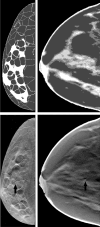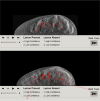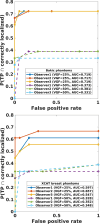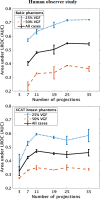This is a preprint.
Examining the Influence of Digital Phantom Models in Virtual Imaging Trials for Tomographic Breast Imaging
- PMID: 38351932
- PMCID: PMC10862940
Examining the Influence of Digital Phantom Models in Virtual Imaging Trials for Tomographic Breast Imaging
Update in
-
Examining the influence of digital phantom models in virtual imaging trials for tomographic breast imaging.J Med Imaging (Bellingham). 2025 Jan;12(1):015501. doi: 10.1117/1.JMI.12.1.015501. Epub 2024 Dec 31. J Med Imaging (Bellingham). 2025. PMID: 39744152
Abstract
Purpose: Digital phantoms are one of the key components of virtual imaging trials (VITs) that aims to assess and optimize new medical imaging systems and algorithms. However, these phantoms vary in their voxel resolution, appearance and structural details. This study aims to examine whether and how variations between digital phantoms influence system optimization with digital breast tomosynthesis (DBT) as a chosen modality.
Methods: We selected widely used and open access digital breast phantoms generated with different methods. For each phantom type, we created an ensemble of DBT images to test acquisition strategies. Human observer localization ROC (LROC) was used to assess observer performance studies for each case. Noise power spectrum (NPS) was estimated to compare the phantom structural components. Further, we computed several gaze metrics to quantify the gaze pattern when viewing images generated from different phantom types.
Results: Our LROC results show that the arc samplings for peak performance were approximately 2.5° and 6° in Bakic and XCAT breast phantoms respectively for 3-mm lesion detection task and indicate that system optimization outcomes from VITs can vary with phantom types and structural frequency components. Additionally, a significant correlation (p¡0.01) between gaze metrics and diagnostic performance suggests that gaze analysis can be used to understand and evaluate task difficulty in VITs.
Conclusion: Our results point to the critical need to evaluate realism in digital phantoms as well as ensuring sufficient structural variations at spatial frequencies relevant to the signal size for an intended task. In addition, standardizing phantom generation and validation tools might aid in lower discrepancies among independently conducted VITs for system or algorithmic optimizations.
Figures








References
-
- Bakic P, Myers K, Reiser I, Kiarashi N, and Zeng R. Virtual tools for validation of x-ray breast imaging systems. Medical Physics, 40(6Part23):390–390, 2013.
-
- Badano Aldo, Badal Andreu, Glick Stephen, Christian G Graff Frank Samuelson, Sharma Diksha, and Zeng Rongping. In silico imaging clinical trials for regulatory evaluation: initial considerations for victre, a demonstration study. In Medical Imaging 2017: Physics of Medical Imaging, volume 10132, page 1013220. International Society for Optics and Photonics, 2017.
-
- Das Mini and Gifford Howard C. Comparison of model-observer and human-observer performance for breast tomosynthesis: effect of reconstruction and acquisition parameters. In Medical Imaging 2011: Physics of Medical Imaging, volume 7961, page 796118. International Society for Optics and Photonics, 2011.
-
- Das Mini, Liang Zhihua, and Gifford Howard C. Examining wide-arc digital breast tomosynthesis: optimization using a visual-search model observer. In SPIE Medical Imaging, pages 94121S–94121S. International Society for Optics and Photonics, 2015.
-
- Barufaldi Bruno, Higginbotham David, Bakic Predrag R, and Maidment Andrew DA. Openvct: a gpu-accelerated virtual clinical trial pipeline for mammography and digital breast tomosynthesis. In Medical Imaging 2018: Physics of Medical Imaging, volume 10573, page 1057358. International Society for Optics and Photonics, 2018.
Publication types
Grants and funding
LinkOut - more resources
Full Text Sources
